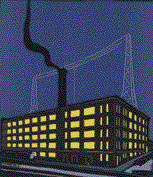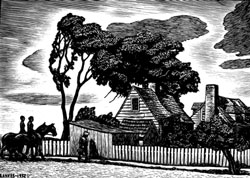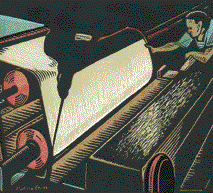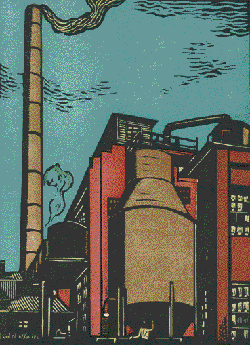|
Block. Ink. Paper. |
|
THE PRINTS OF |
|
J.J. Lankes & Charles W. Smith |
|

|

|
The Lane.
J. J. Lankes. 1929. Woodcut.
The Library of Virginia |
Home of Edgeworth
Smoking
Tobacco
and Radio Station WRVA.
Charles W. Smith. 1927.
Colored linoleum |
|
|
|
|
4 June 2001 - 1 December 2001
An exhibition at The Library of Virginia
|
|
|
|

|
Julius John Lankes (1884-1960)
|
|
Southern Scene. J. J.
Lankes. 1930.
Woodcut |
| A native of Buffalo, New York, Julius
John Lankes (1884-1960) achieved national recognition for his
mastery of woodcut printing. His works, numbering about thirteen
hundred, helped elevate woodblock prints beyond illustrations in
commercial productions to recognition as a fine art. Lankes graduated
from the Buffalo Commercial and Electro-Mechanical Institute in 1902 and
worked as a draftsman specializing in patent drawings before continuing
his art studies at the Art Students' League of Buffalo and the Boston
Museum of Fine Arts School. Unsuccessful in painting, Lankes turned his
attention to woodblock printing and recorded his first woodcut in 1917.
His skill was recognized early. Bolton Brown, a respected lithographer,
published a pamphlet on Lankes's work in 1921 and the following year
Wilbur Macey Stone's book on Lankes's bookplate designs was
published by Frank J. Lankes, the artist's brother. In 1923 Lankes and
poet Robert Frost began a friendship and artistic collaboration that
lasted more than forty years. Lankes produced woodcuts to illustrate not
only Frost's poems but also works by Roark Bradford, R. P. T. Coffin,
August Derleth, and Ellen Glasgow. In 1925, after a brief visit to
Europe, Lankes and his family moved to Hilton Village, near Newport
News, Virginia. He accepted a lectureship at Wells College in Aurora,
New York, in 1932. For the next seven years, Lankes taught at Wells
College and visited his family in Virginia only during the summers.
Lankes joined the reproduction section of the National Advisory
Committee for Aeronautics in 1943, where he remained until 1950. In 1951
Lankes moved to Durham, North Carolina. He suffered a debilitating
stroke in 1959 and died on 22 April 1960 in Durham. J. J. Lankes was
buried in Buffalo on 25 April 1960.
|

|
Lankes worked exclusively in woodcut, making his own blocks out of
fruitwoods such as apple and pear. He distinguished between woodcuts,
which were cut with gouges along the grain, and wood engravings, which
were cut with gravers against the end-grain.
His work was praised for its fidelity to nature and for its evocation
of mood. In a review published in Woodcut Bulletin, Genevieve
Taggard wrote that Lankes "has caught the South-children swinging
in old gardens, washing flapping, hound-dogs scratching, horses
drooping; and none too soon; just in time, in fact, before it passes imperceptibly, and is quite gone." Another reviewer wrote
that "whether he knows it or not, Mr. Lankes' work fills us with a
sense of tragedy . . . [that] is the result of a deep sympathy for
unattractive conditions of life." In his 1934 book No Swank, Sherwood
Anderson wrote of Lankes's woodcuts, "I like things in my
dining-room that arouse, that awaken thoughts in me. So I have these
Lankes woodcuts. . . . I honor him for his realism. The man has feeling.
He has that odd quality, so infinitely valuable, the feeling for things,
for the reflected life in things."
|
|
Lankes in his workshop,
Hilton Village.
Virginia Chamber of Commerce,
The Library of Virginia |
|
|

|
Charles William Smith (1893-1987) |
|
Interior of Cellophane
Plant in Virginia.
Charles W. Smith.ca. 1930.
Colored linoleum. The Library of Virginia |
| Born in Lofton, Virginia, in 1893, Charles
William Smith studied at the University of Virginia summer school, the
Corcoran Art School, and Yale University's School of Fine Arts. He
taught at the University of Virginia, the College of William and Mary, and
the New York School of Printing. Smith moved to Richmond in 1925 where he
worked as an artist for Whittet & Shepperson, a local printing firm.
In 1929 he taught art at the Richmond Division of the College of William
and Mary. For the next four years, Smith worked out of his apartment on
Monument Avenue as a commercial artist. He became chair of the art
department at Bennington College in Bennington, Vermont, in 1936 and
taught there until 1947. Smith taught at the University of Virginia from
1947 until his retirement in 1963 and was the first chairman of the art
department. Charles W. Smith died in Charlottesville in 1987.
|
 |
Smith learned how to use gouges and
chisels from his father, a patternmaker for local industries. Early in his
career he turned to linoleum block printing. He explained in his 1926
book, Linoleum Block Printing, that the basic techniques for
linoleum block and wood block were similar. The artist transferred his
design to the block and then cut the design in relief. Areas not to be
printed were cut away. The difference lay in the inability of the linoleum
to permit fine lines or much detail. Linoleum blocks produced prints with
large areas of color and minimal lines.
Unlike Lankes, Smith was often experimental. A nationally recognized
printmaker, Smith also was an accomplished book designer. His Old
Virginia in Block Prints, chosen as one of the "Fifty Books of the
Year" for 1929 by the American Institute of Graphic Arts, was a
collection of linoleum block prints. He published woodcuts in his books on
Charleston (1933) and the University of Virginia (1937), but ventured
beyond representational printmaking in the 1940s. Smith created a method
of block painting to explore abstract forms. He published two books of his
block paintings, Animal Fare and My Zoological Garden. |
|
Charles W. Smith, 1959.
University of Virginia Media Services |
| |
|
Suggested activities for Teachers |
 |
Sectional of a Pulp Mill, West Point,
Va.
Charles W. Smith. ca. 1930.
Colored linoleum. |
| The following activities support the
Library of Virginia exhibition Block. Ink. Paper.: The Prints of J.J.
Lankes and Charles W. Smith.
Printmaking is art, created when an original source image on one
surface is transferred to another surface, usually paper.
- Students should define the following terms and distinguish the
difference in techniques: woodcut, wood engraving, lithography,
linoleum block prints. Have students identify other methods of printmaking.
- Students can develop their own technique of transferring an image to
create a print. Encourage them to evoke mood in their work as did artist
J.J. Lankes.
- Students can write a poem and create a print to accompany it. As a
group project, compile poems and prints into a bound book.
- Students should research 20th-century poets and writers and identify
works that are accompanied by prints. Identify the role the print played
in conveying the message of the written word.
- Students should research the history of printmaking and the development
of illustrated books (here's a hint, the school of Ukiyo-e in Japan).
|
| |
|